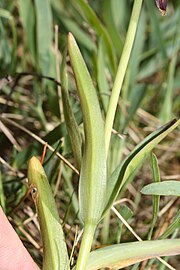
Lilium is a genus of herbaceous flowering plants growing from bulbs, all with large and often prominent flowers. They are the true lilies. Lilies are a group of flowering plants which are important in culture and literature in much of the world. Most species are native to the Northern Hemisphere and their range is temperate climates and extends into the subtropics. Many other plants have "lily" in their common names, but do not belong to the same genus and are therefore not true lilies.

Camassia is a genus of plants in the asparagus family native to North America. Common names include camas, quamash, Indian hyacinth, camash, and wild hyacinth.

Camassia quamash, commonly known as camas, small camas, common camas, common camash or quamash, is a perennial herb. It is native to western North America in large areas of southern Canada and the northwestern United States.
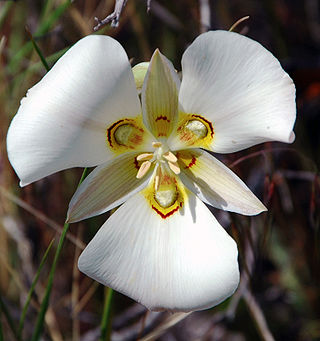
Calochortus is a genus of flowering plants in the lily family. The group includes herbaceous, perennial and bulbous species, all native to North America.

Lilium humboldtii, or Humboldt's lily, is a species of lily native to the US state of California and the Mexican state of Baja California. It is named after naturalist and explorer Alexander von Humboldt. It is native to the South High Cascade Range, High Sierra Nevada, south Outer South Coast Ranges, and the Santa Monica Mountains and others in Southern California, growing at elevations from 600 metres (2,000 ft) to 1,200 metres (3,900 ft).

Hemerocallis fulva, the orange day-lily, tawny daylily, corn lily, tiger daylily, fulvous daylily, ditch lily or Fourth of July lily, is a species of daylily native to Asia. It is very widely grown as an ornamental plant in temperate climates for its showy flowers and ease of cultivation. It is not a true lily in the genus Lilium, but gets its common name from the superficial similarity of its flowers to Lilium and from the fact that each flower lasts only one day.

Fritillaria pudica, the yellow fritillary, is a small perennial plant found in the sagebrush country in the western United States and Canada. It is a member of the lily family Liliaceae. Another common name is "yellow bells", since it has a bell-shaped yellow flower. It may be found in dryish, loose soil; it is amongst the first plants to flower after the snow melts, but the flower does not last very long; as the petals age, they turn a brick-red colour and begin to curl outward. The flowers grow singly or in pairs on the stems, and the floral parts grow in multiples of threes. The species produces a small corm, which forms corms earning the genus the nickname 'riceroot'. During his historic journey, Meriwether Lewis collected a specimen while passing through Idaho in 1806.

Fritillaria biflora, the chocolate lily or mission bells, is a species of fritillary native to western California, US, and northern Baja California, Mexico. It occurs in the chaparral and woodlands ecoregion, often in serpentine soil formations and hillside grassland habitats.
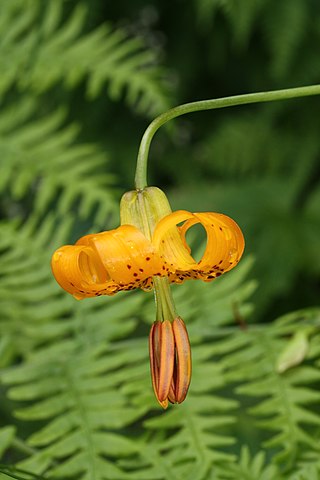
Lilium columbianum is a lily native to western North America. It is also known as the Columbia lily, Columbia tiger lily, or simply tiger lily.

Fritillaria camschatcensis is a species of flowering plant native to northeastern Asia and northwestern North America, including northern Oregon, Washington, British Columbia, Alaska, northern Japan, and the Russian Far East. It has many common names, including Kamchatka fritillary and Kamchatka lily.

Fritillaria verticillata is a flowering plant in the lily family Liliaceae, native to Japan, Korea, Mongolia, Xinjiang, Kazakhstan and the Altay region of Siberia.
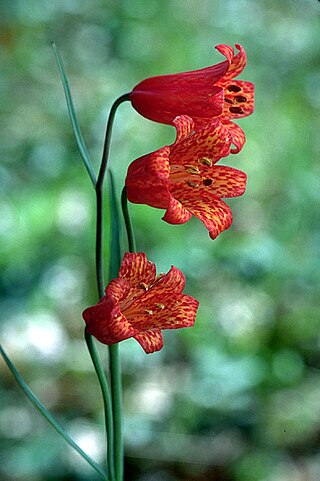
Fritillaria recurva, the scarlet fritillary, is a North American bulb-forming herbaceous perennial plant in the lily family Liliaceae. It is native to the western United States, from southwest Oregon down to northern California where it grows in the Klamath Mountains, Northern Coast Ranges, Cascade Range, and Sierra Nevada. Most of the known Californian locations are in the northern half of the state, as far south as Solano and El Dorado Counties, but there are isolated populations in Tulare and Mariposa Counties. The species has also been reported from Douglas and Washoe Counties in Nevada. It grows in dry, open woodlands and chaparral at 300–2,200 metres (980–7,220 ft), and it blooms in spring from February to July.
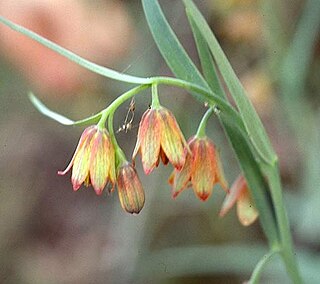
Fritillaria eastwoodiae, also known as Butte County fritillary or Eastwood's fritillary is a rare member of the Lily family (Liliaceae), native to the foothills of the northern Sierra Nevada, and Cascade Mountains in California and southern Oregon, USA.

Erythronium oregonum is a North American species of flowering plant in the lily family which is known by the common name giant white fawnlily or Oregon fawn-lily.
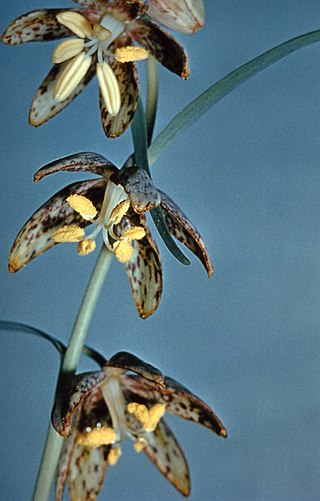
Fritillaria atropurpurea is a species of fritillary known by several common names, including spotted fritillary, purple fritillary, spotted mountainbells, spotted missionbells, and leopard lily.

Ribes aureum, known by the common names golden currant, clove currant, pruterberry and buffalo currant, is a species of flowering plant in the genus Ribes native to North America.

Brodiaea coronaria is the type species of Brodiaea and also known by the common names harvest brodiaea and crown brodiaea. It is native to western North America from British Columbia to northern California, where it grows in mountains and grasslands.

Fritillaria purdyi, the Purdy's fritillary, is a rare species of flowering plant in the lily family Liliaceae.
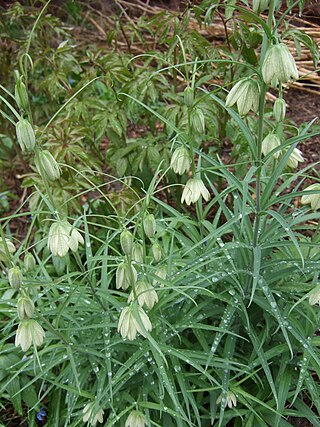
Fritillaria thunbergii is a flowering plant species in the lily family Liliaceae. It is native to Kazakhstan and in Xinjiang Province of western China, though cultivated in other places and naturalized in Japan and in other parts of China.

Calochortus longibarbatus is a species of flowering plant in the lily family with the common names long-haired star-tulip and longbeard mariposa lily. It is native to Oregon, Washington, and northern California, where it grows in the forest and woodlands of the mountains.



